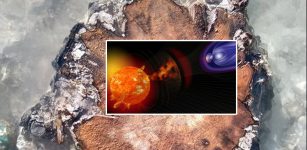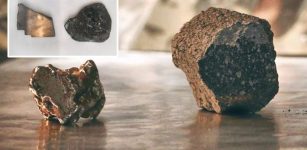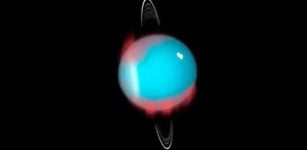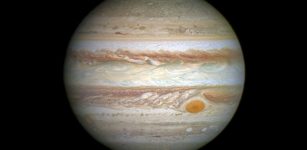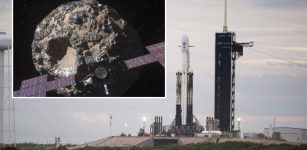9 Phenomena Astronauts Will Encounter At The Moon’s South Pole
Eddie Gonzales Jr. – MessageToEagle.com – NASA’s Artemis campaign will send the first woman and the first person of color to the moon’s south polar region, marking humanity’s first return to the lunar surface in more than 50 years.
This graphic shows maximum summer and winter temperatures near the lunar South Pole. Purple, blue, and green identify cold regions, while yellow to red signify warmer ones. The graphic incorporates 10 years of data from NASA’s LRO (Lunar Reconnaissance Orbiter), which has been orbiting the Moon since 2009. Credit: NASA/LRO Diviner Seasonal Polar Data
Here are some out-of-this-world phenomena Artemis astronauts will experience:
1. A hovering sun and giant shadows
Near the moon’s South Pole, astronauts will see dramatic shadows that are 25 to 50 times longer than the objects casting them. Why? Because the sun strikes the surface there at a low angle, hanging just a few degrees above the horizon. As a result, astronauts won’t see the sun rise and set. Instead, they’ll watch it hover near the horizon as it moves horizontally across the sky.
2. Sticky, razor-sharp dust …
The lunar dust, called regolith, that coats the moon’s surface looks fine and soft like baking powder. But looks can be deceiving. Lunar regolith is formed when meteoroids hit the moon’s surface, melting and shattering rocks into tiny, sharp pieces. The moon doesn’t have moving water or wind to smooth out the regolith grains, so they stay sharp and scratchy, posing a risk to astronauts and their equipment.
3. … that’s charged with static electricity
Because the moon has no atmosphere to speak of, its surface is exposed to plasma and radiation from the sun. As a result, static electricity builds up on the surface, as it does when you shuffle your feet against a carpeted floor. When you then touch something, you transfer that charge via a small shock. On the moon, this transfer can short-circuit electronics. Moon dust also can make its way into astronaut living quarters, as the static electricity causes it to easily stick to spacesuits. NASA has developed methods to keep the dust at bay using resistant textiles, filters, and a shield that employs an electric field to remove dust from surfaces.
4. A new sense of lightness
In 1972, Apollo 16 astronaut Charles Duke hammered a core tube into the moon’s surface until it met a rock and wouldn’t go any farther. Then the hammer flew from his hand. He made four attempts to pick it up by bending down and leaning to reach for it. He gave up and returned to the rover to get tongs to finally pick up the hammer successfully.
Artemis moonwalkers will have a bounce to their step as they traverse the lunar surface. This is because gravity won’t pull them down as forcefully as it does on Earth. The moon is only a quarter of Earth’s size, with six times less gravity. Simple activities, like swinging a rock hammer to chip off samples, will feel different. While a hammer will feel lighter to hold, its inertia won’t change, leading to a strange sensation for astronauts. Lower gravity has perks, too. Astronauts won’t be weighed down by their hefty spacesuits as much as they would be on Earth. Plus, bouncing on the moon is just plain fun.
5. A waxing crescent … Earth?
When Artemis astronauts look at the sky from the moon, they’ll see their home planet shining back at them. Just like Earthlings see different phases of the moon throughout a month, astronauts will see an ever-shifting Earth. Earth phases occur opposite to moon phases: When Earth experiences a new moon, a full Earth is visible from the moon.
6. An itty-bitty horizon
Because the moon is smaller than Earth, its horizon will look shorter and closer. To someone standing on a level Earth surface, the horizon is 3 miles away, but to astronauts on the moon, it’ll be only 1.5 miles away, making their surroundings seem confined.
This dust particle came from a lunar regolith sample brought to Earth in 1969 by Apollo 11 astronauts. The particle is about 25 microns across, less than the width of an average human hair. The image was taken with a scanning electron microscope. Credit: NASA/Sarah Noble
7. Out-of-this-world temperatures
Because sunlight at the moon’s South Pole skims the surface horizontally, it brushes crater rims, but doesn’t always reach their floors. Some deep craters haven’t seen the light of day for billions of years, so temperatures there can dip to minus 334 F. That’s nearly three times colder than the lowest temperature recorded in Antarctica. At the other extreme, areas in direct sunlight, such as crater rims, can reach temperatures of 130 F.
8. An inky-black sky
The moon, unlike Earth, doesn’t have a thick atmosphere to scatter blue light, so the daytime sky is black. Astronauts will see a stark contrast between the dark sky and the bright ground.
9. A rugged terrain
Artemis moonwalkers will find a rugged landscape that takes skill to traverse. The moon has mountains, valleys, and canyons, but its most notable feature for astronauts on the surface may be its millions of craters. Near the South Pole, gaping craters and long shadows will make it difficult for astronauts to navigate. But, with training and special gear, astronauts will be prepared to meet the challenge.
Written by Eddie Gonzales Jr. – MessageToEagle.com Staff Writer


